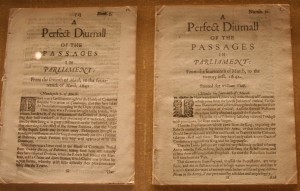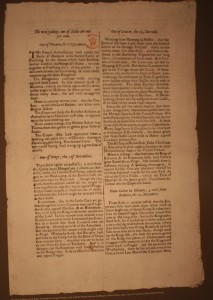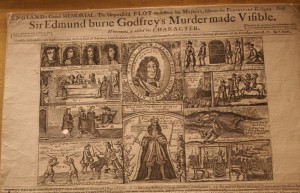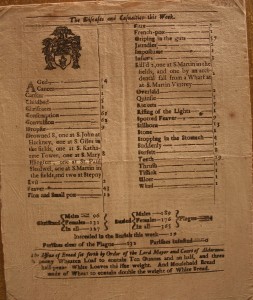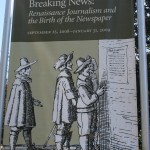 The Folger Library in Washington, D.C. is best known for housing one of the world’s great Sheakespeare collections, but on a visit last weekend we were intrigued to discover that it’s currently also hosting an exhibit on early newspapers.
The Folger Library in Washington, D.C. is best known for housing one of the world’s great Sheakespeare collections, but on a visit last weekend we were intrigued to discover that it’s currently also hosting an exhibit on early newspapers.
We’re talking very early newspapers, as in those that emerged within the first couple of centuries after the printing press was developed. The style and topical choices of those early efforts look strange and even comical now, but you can see elements of modern organization and editorial voice emerging. In fact, the exhibit points out that many standards of layout, arrangement and frequency are over 300 years old.
I took a few notes and snapped a few photos before being politely informed that photography was prohibited (click on the images to see enlargements). The history of newspapers is fascinating. They were an almost instant success.
They were also a distant mirror of today’s explosion of blogs and citizen media. Back in the 17th century, there were no commercial newspaper publishers. Journals were published by people who had the skill and money to use the press to promote an agenda. Often, these people had strong political biases or they wrote salacious accounts purely for the purpose of selling papers. There was no such thing as impartial journalism. Every title produced by these “pamphleteers” had something to sell.
Yet the public evidently found value in what they said, because newspapers were an immediate success. Favorite topics included freakish occurrences: giant storms, conjoined twins, murder, atrocities and the supernatural. In fact, early newspapers were so sensational that Ben Jonson was moved to ridicule readers for “wasting money on salacious and inaccurate news.”
Not all of it was inaccurate, though. The Thirty Years’ War (1618-1648) gave birth to the modern newspaper. Citizens wanted to know how the conflict was going on the continent and whether England was going to be drawn in. A small number of professional journalists made a living reporting the facts of the war for anyone who would pay them. Their reports were hugely popular in England. Prior to the 17th century, news had been passed entirely by personal letter and word-of-mouth, which quickly distorted the facts. While early newspapers weren’t always accurate or unbiased, they were a lot better than the system that preceded them.
The English press was heavily regulated throughout much of the 17th century, but rogue publishers constantly sprouted up to do battle with the government. Publishing was dangerous in a day when ordinary mail was routinely scanned by law enforcement officials for evidence of treason. if you could be arrested for what you said in a letter, imagine the risks taken by a pamphleteer!
Drop by the exhibit if you’re in the D.C. area before Jan. 31, 2009. Here are a few other nuggets I learned:
- The first newspapers were called “corantos”. That word later became “courant.”
- The first courant was the Conventicle Courant of 1682. The first daily courant was published in 1702. The Hartford, Conn. Courant is a descendant of those first journals and is the only newspaper in the US to still call itself a courant.
- The first newspaper to call itself a “post” was probably The London Post of 1644.
- The first known illustrated ad appeared in 1680. It was for a mysterious product called “Indian water-works.”
- The weekly newspaper report of London deaths in 1680 included 57 people who died from “griping in the guts,” 29 from “teeth” and 2 from “evil.”
Comments
This entry was posted on Thursday, November 6th, 2008 at 9:50 am and is filed under Fake News. You can follow any responses to this entry through the RSS 2.0 feed. Both comments and pings are currently closed.
